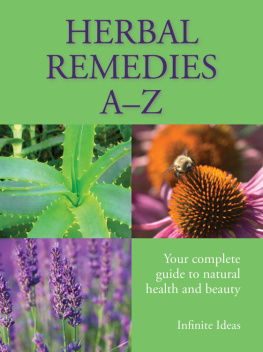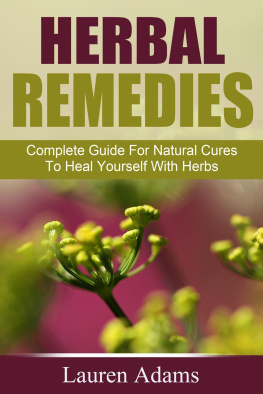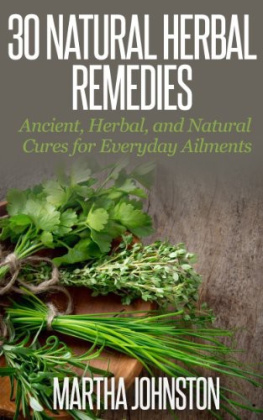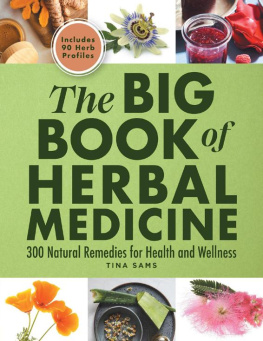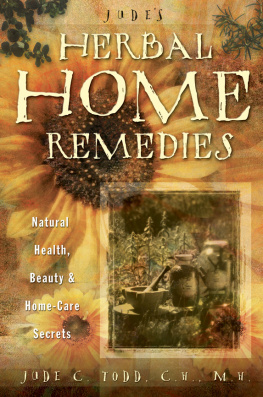Herbal remedies AZ
Your complete guide to natural health and beauty
Infinite Ideas with Barbara Griggs

Introduction
Herbs have been used for thousands of years to treat all sorts of ailments. You may think that with the scientific advances weve experienced in the last few centuries wed have eradicated the need for their use, but they are still hugely popular with many people. Perhaps its their widespread availability, their low incidence of side-effects or their relatively low cost compared to pharmaceutical medicines that makes them ever popular. Or perhaps its that, while their efficacy has been difficult to prove in scientific studies, their benefit has been demonstrated through use over the centuries.
Herbs are particularly useful to keep by you for minor ailments and emergencies. So a tube of aloe vera is handy for minor scalds and sunburn; echinacea is useful to keep in stock in case you feel yourself coming down with a cold and lavender is your friend in many situations, from insect bites to simply relaxing after a stressful day.
If you are really serious about pursuing a herbal treatment for a more serious or ongoing condition its a great idea to visit a herbalist. There is a huge array of herbs out there and picking which ones to use can be confusing for a novice. A qualified herbalist will understand which herbs work best together and also which work best with you . Thats because, like many other so-called alternative practitioners, herbalists take time to find out all about you, so they can treat you as a whole rather than just honing in on specific symptom.
Needless to say if you are suffering from anything serious you should consult your doctor first. Its also important to note that some herbs can interact with prescription medication so you should check with your doctor or a qualified herbalist before taking any herbs if youre already taking other medicines.
Think of this book as a guide to your herbal medicine cabinet. We hope that you find it a handy reference that you can turn to time and time again. For more information on specific ailments you may find its parent publication Helpful herbs for health and beauty valuable.
A
aloe vera
Every home should have a tube of aloe vera gel; its marvellous first aid for burns, scalds, sunburn and itchy or irritated skin. It can even help cool the agonising inflammation of shingles. Aloe vera soothes pain, calms inflammation, and speeds the healing process by stimulating the growth of new tissue.
In the case of severe burns sunburn or any other kind get professional help urgently to deal with the shock, dehydration and systemic infection that can result. Minor burns, scalds or ordinary sunburn can, however, be dealt with effectively with aloe vera. The kitchen staff of many restaurants keep a big tube of aloe vera gel handy to deal with scalds so why not make it part of your home first-aid kit?
Dont forget that the first priority is to cool the area by spraying or soaking it with cold water. For sunburn use the gel liberally or if you live or are holidaying in an area where the plant grows (such as the Mediterranean) find an aloe vera plant, hack off a fat fleshy leaf, slice it open, and appy the gooey, green, jelly-like inside directly to the sunburnt area. The pain will easd off and, if you act quickly enough, there should be no blisters.
See also Angostura Bitters see apples
An old European fruit cure for diarrhoea is the common apple, grated raw and unpeeled (so ideally use organically grown apples) or sliced and cooked into a light pure. Apples are rich in pectin, a soluble fibre that helps soak up toxins and soothe the gut. They also supply plenty of the vital minerals, including potassium, which are lost in diarrhoea. Drink plenty of water, too; preferably bottled. If the diarrhoea isnt any better after a couple of days especially in the case of small children or if theres blood in your stool, seek medical help.
For hay fever eat plenty of apples (as well as berries and red or yellow onions): theyre rich in a flavonoid called quercetin which helps quell inflammation.
arnica
A gorgeous little yellow flower which grows in high mountain meadows, arnica has been used for centuries by country people to treat bruises, sprains, strains, swelling and fractures, and calm the pain that they cause. Its a marvellous remedy to keep on hand in your first-aid kit. You can buy it as a tincture or cream, but the gel is easiest to apply. When using the tincture diluted one part to five of water before appling to the skin or add a little to your bath to soak away your aches and pains.
In a clinical trial, arnica gel was as effective as ibuprofen at reducing the pain and inflammation and improving the flexibility of swollen osteoarthritic hands. Use it on any joint especially last thing at night, so that theyre less stiff on waking.
Caution: some people, especially pale-skinned redheads, can have a irritated skin reaction to arnica, so do a patch test before using it. Arnica should never be applied where the skin is broken, cut or irritated, and should not be taken internally.
arctic root ( Rhodiola rosea )
This great herbal tonic comes from Russian folk medicine. For centuries the roots of Rhodiola rosea or Arctic root, were chewed to stave off fatigue and exhaustion, and boost general endurance. Studies carried out by modern Russian researchers have demonstrated this useful property in among other subjects sleep-deprived doctors, hard worked army cadets and students facing key exams. Try it as a tea, a tincture or herbal capsules.
ashwaganda ( Withania somnifera )
Ashwaganda, sometimes known as Indian ginseng, is a key herb in Ayurveda, the thousands-year-old traditional medicine of India, and since it grows easily and happily from seed around the world, it has become increasingly popular with Western herbalists faced with deeply stressed patients. An exceptional nerve tonic one of the best remedies for stress, says UK herbalist Anne McIntyre. From my observation of patients taking ashwaganda over a period of four to six weeks, it certainly helps to enhance energy and positivity, engender calmness and clarity, improve memory and concentration, and promote restful sleep.
Ashwaganda is also useful for sexual or reproductive problems. US herbalist Michael Tierra describes it as almost specific for impotence. Good clinical trials that indicate this effect are yet to be carried out, but what is certainly true of ashwaganda is that it can reduce anxiety, boost the immune system generally and combat physical stress, all of which might help solve a lot of performance problems.
Infertile couples are usually deeply stressed by months of alternating hope and despair. Ashwaganda is a wonderful strengthening tonic for men and women alike, and is both safe and effective. Visit www.fertility.com.au for more on this.
Finally, ashwaganda is a great calming tonic for asthma; take a course of it before winter or if you suffer from allergies.
astragalus root
Astragalus root has been intensively studied by Western scientists. They found that it has an impressive range of immune activating properties. The conclusion being drawn by most Western herbalists, comments leading US herbal authority David Hoffmann, is that astragalus is an ideal remedy for anyone who might be immuno-compromised in any way. This can range from someone who easily catches cold to someone with cancer.
Astragalus is extremely safe, with no known toxicity or adverse effects.
B
barley
Barley water was Victorian sick-room staple and with good reason: this marvellous grain helps restore energy, revive appetite, rebuild strength and generally speed recovery from illness. It helps heal inflammatory conditions right through the gut. And its also rich in vitamins and minerals, especially iron and B vitamins. To make barley water, put 50g of unrefined pot barley in a pan with 600ml of water, bring to the boil and simmer for thirty minutes. Add 1 1/2 tablespoons of honey and stir well. Cool, strain, add the juice of half a lemon and drink it, lukewarm, throughout the day.
Next page
